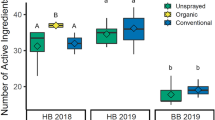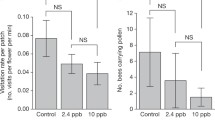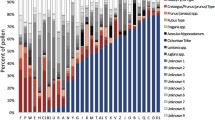Abstract
Pesticides are implicated in current bee declines. Wild bees that nest or forage within agroecosystems may be exposed to numerous pesticides applied throughout their life cycles, with potential additive or synergistic effects. In pollinator-dependent crops, pesticides may reduce bee populations, creating trade-offs between pest management and crop pollination. In this three-year study, we examined the effects of pesticides on the abundance and species richness of wild bees within apple orchards of southern Wisconsin. We additionally deployed colonies of Bombus impatiens, a native and common species, in order to relate colony performance to orchard pesticide use. Utilizing grower spray records, we developed “toxicity scores” as a continuous index of pesticide use for each orchard, a measure that incorporated each pesticide’s relative toxicity to bees, its residual activity, and its application rate. While there was no relationship between total wild bee abundance and species richness with toxicity scores, there was a significant, negative effect on sweat bees, Lasioglossum spp. Many of these sweat bees are small-bodied, have short foraging ranges, are social, and have long foraging periods, all traits that could increase bee exposure or sensitivity to orchard pesticides. In addition, sentinel bumble bee colonies at orchards with high toxicity scores produced fewer, and smaller, workers. Bumble bees may also have a greater sensitivity and exposure to orchard pesticides due to their sociality and long foraging periods. Our results demonstrate that certain bee taxa may have a higher exposure or sensitivity to on-farm pesticide applications, and could therefore be vulnerable in agroecosystems.



Similar content being viewed by others
References
Abbott VA, Nadeau JL, Higo HA, Winston ML (2008) Lethal and sublethal effects of Imidacloprid on Osmia lignaria and Clothianidin on Megachile rotundata (Hymenoptera: Megachilidae). J Econ Entomol 101:784–796. doi:10.1603/0022-0493(2008)101[784:LASEOI]2.0.CO;2
Andersson GKS, Rundlöf M, Smith HG (2012) Organic farming improves pollination success in strawberries. PLoS one 7:e31599. doi:10.1371/journal.pone.0031599
Arena M, Sgolastra F (2014) A meta-analysis comparing the sensitivity of bees to pesticides. Ecotoxicology 23:324–334. doi:10.1007/s10646-014-1190-1
Baron GL, Raine NE, Brown MJF (2014) Impact of chronic exposure to a pyrethroid pesticide on bumblebees and interactions with a trypanosome parasite. J Appl Ecol 51:460–469. doi:10.1111/1365-2664.12205
Biesmeijer JC, Roberts SPM, Reemer M et al (2006) Parallel declines in pollinators and insect-pollinated plants in Britain and the Netherlands. Science 313:351–354. doi:10.1126/science.1127863
Brittain C, Potts SG (2011) The potential impacts of insecticides on the life-history traits of bees and the consequences for pollination. Basic Appl Ecol 12:321–331
Brittain C, Bommarco R, Vighi M et al (2010) Organic farming in isolated landscapes does not benefit flower-visiting insects and pollination. Biol Conserv 143:1860–1867. doi:10.1016/j.biocon.2010.04.029
Burkle LA, Marlin JC, Knight TM (2013) Plant-pollinator interactions over 120 years: loss of species, co-occurrence, and function. Science 339:1611–1615. doi:10.1126/science.1232728
Burnham KP, Anderson DR (eds) (2004) Model selection and multimodel inference. Springer, New York
Colla SR, Packer L (2008) Evidence for decline in eastern North American bumblebees (Hymenoptera: Apidae), with special focus on Bombus affinis Cresson. Biodivers Conserv 17:1379–1391. doi:10.1007/s10531-008-9340-5
Cresswell JE (2011) A meta-analysis of experiments testing the effects of a neonicotinoid insecticide (imidacloprid) on honey bees. Ecotoxicology 20:149–157. doi:10.1007/s10646-010-0566-0
Desneux N, Decourtye A, Delpuech JM (2007) The sublethal effects of pesticides on beneficial arthropods. Annu Rev Entomol 52:81–106. doi:10.1146/annurev.ento.52.110405.091440
Eilers EJ, Kremen C, Smith Greenleaf S et al (2011) Contribution of pollinator-mediated crops to nutrients in the human food supply. PLoS one 6:e21363. doi:10.1371/journal.pone.0021363
Eshenaur B, Grant J, Kovach J, et al (2010) Environmental impact quotient: “a method to measure the environmental impact of pesticides.” New York State Integrated Pest Management Program, Cornell Cooperative Extension, Cornell University. www.nysipm.cornell.edu/publications/EIQ
Fauser-Misslin A, Sadd BM, Neumann P, Sandrock C (2014) Influence of combined pesticide and parasite exposure on bumblebee colony traits in the laboratory. J Appl Ecol 51:450–459. doi:10.1111/1365-2664.12188
Gallai N, Salles J-M, Settele J, Vaissière BE (2009) Economic valuation of the vulnerability of world agriculture confronted with pollinator decline. Ecol Econ 68:810–821. doi:10.1016/j.ecolecon.2008.06.014
Garibaldi LA, Steffan-Dewenter I, Winfree R et al (2013) Wild pollinators enhance fruit set of crops regardless of honey bee abundance. Science 339:1608–1611. doi:10.1126/science.1230200
Gathmann A, Tscharntke T (2002) Foraging ranges of solitary bees. J Anim Ecol 71:757–764. doi:10.1046/j.1365-2656.2002.00641.x
Gels JA, Held DW, Potter DA (2002) Hazards of insecticides to the bumble bees Bombus impatiens (Hymenoptera: Apidae) foraging on flowering white clover in turf. J Econ Entom 95:722–728. doi:10.1603/0022-0493-95.4.722
Gibbs J (2011) Revision of the metallic Lasioglossum (Dialictus) of eastern North America (Hymenoptera: Halictidae: Halictini). Zootaxa 3073:1–216
Gill RJ, Ramos-Rodriguez O, Raine NE (2012) Combined pesticide exposure severely affects individual- and colony-level traits in bees. Nature 491:105–108. doi:10.1038/nature11585
Greenleaf SS, Williams NM, Winfree R, Kremen C (2007) Bee foraging ranges and their relationship to body size. Oecologia 153:589–596. doi:10.1007/s00442-007-0752-9
Henry M, Béguin M, Requier F et al (2012) A common pesticide decreases foraging success and survival in honey bees. Science 336:348–350. doi:10.1126/science.1215039
Holzschuh A, Steffan-Dewenter I, Kleijn D, Tscharntke T (2007) Diversity of flower-visiting bees in cereal fields: effects of farming system, landscape composition and regional context. J Appl Ecol 44:41–49. doi:10.1111/j.1365-2664.2006.01259.x
Holzschuh A, Steffan-Dewenter I, Tscharntke T (2008) Agricultural landscapes with organic crops support higher pollinator diversity. Oikos 117:354–361. doi:10.1111/j.2007.0030-1299.16303.x
Holzschuh A, Steffan-Dewenter I, Tscharntke T (2010) How do landscape composition and configuration, organic farming and fallow strips affect the diversity of bees, wasps and their parasitoids? J Anim Ecol 79:491–500. doi:10.1111/j.1365-2656.2009.01642.x
Kennedy CM, Lonsdorf E, Neel MC et al (2013) A global quantitative synthesis of local and landscape effects on wild bee pollinators in agroecosystems. Ecol Lett 16:584–599. doi:10.1111/ele.12082
Kovach J, Petzoldt C, Degni J, Tette J (1992) A method to measure the environmental impact of pesticides. New York food and life sciences Bulletin Number 139. Cornell University, New York
Kremen C, Williams NM, Thorp RW (2002) Crop pollination from native bees at risk from agricultural intensification. PNAS 99:16812–16816. doi:10.1073/pnas.262413599
Kremen C, Williams NM, Bugg RL et al (2004) The area requirements of an ecosystem service: crop pollination by native bee communities in California. Ecol Lett 7:1109–1119. doi:10.1111/j.1461-0248.2004.00662.x
Ladurner E, Bosch J, Kemp WP, Maini S (2005) Assessing delayed and acute toxicity of five formulated fungicides to Osmia lignaria Say and Apis mellifera. Apidologie 36:449–460. doi:10.1051/apido:2005032
Larson JL, Redmond CT, Potter DA (2013) Assessing insecticide hazard to bumble bees foraging on flowering weeds in treated lawns. PLoS one 8:e66375. doi:10.1371/journal.pone.0066375
Mallinger RE, Gratton C (2015) Species richness of wild bees, but not the use of managed honeybees, increases fruit set of a pollinator-dependent crop. J Appl Ecol 52:323–330. doi:10.1111/1365-2664.12377
Malone LA, Phyllis E, Burgess J et al (2000) Effects of four protease inhibitors on the survival of worker bumblebees, Bombus terrestris L. Apidologie 31:25–38. doi:10.1051/apido:2000104
Michener CD (1974) The social behavior of the bees: a comparative study. Harvard University Press, Cambridge
Michener CD (2000) The bees of the world. JHU Press, Baltimore
Mommaerts V, Reynders S, Boulet J et al (2010) Risk assessment for side-effects of neonicotinoids against bumblebees with and without impairing foraging behavior. Ecotoxicology 19:207–215. doi:10.1007/s10646-009-0406-2
Morandin LA, Winston ML (2003) Effects of novel pesticides on bumble bee (Hymenoptera: Apidae) colony health and foraging ability. Environ Entomol 32:555–563. doi:10.1603/0046-225X-32.3.555
Morandin LA, Winston ML, Franklin MT, Abbott VA (2005) Lethal and sub-lethal effects of spinosad on bumble bees (Bombus impatiens Cresson). Pest Manag Sci 61:619–626. doi:10.1002/ps.1058
National Research Council (U.S) Committee on the Status of Pollinators in North America (2007) Status of pollinators in North America. National Academies Press, Washington
Osborne JI, Clark SJ, Morris RJ et al (1999) A landscape-scale study of bumble bee foraging range and constancy, using harmonic radar. J Appl Ecol 36:519–533. doi:10.1046/j.1365-2664.1999.00428.x
Park MG, Blitzer EJ, Gibbs J et al (2015) Negative effects of pesticides on wild bee communities can be buffered by landscape context. P Roy Soc B Biol Sci 282:20150299. doi:10.1098/rspb.2015.0299
Pettis JS, Lichtenberg EM, Andree M et al (2013) Crop pollination exposes honey bees to pesticides which alters their susceptibility to the gut pathogen Nosema ceranae. PLoS One 8:e70182. doi:10.1371/journal.pone.0070182
Pilling ED, Jepson PC (1993) Synergism between EBI fungicides and a pyrethroid insecticide in the honeybee (Apis mellifera). Pestic Sci 39:293–297. doi:10.1002/ps.2780390407
Potts SG, Biesmeijer JC, Kremen C et al (2010) Global pollinator declines: trends, impacts and drivers. Trends Ecol Evol 25:345–353. doi:10.1016/j.tree.2010.01.007
Rundlöf M, Andersson GKS, Bommarco R et al (2015) Seed coating with a neonicotinoid insecticide negatively affects wild bees. Nature 521:77–80. doi:10.1038/nature14420
Shuler R, Roulston T, Farris G (2005) Farming practices influence wild pollinator populations on squash and pumpkin. J Econ Entomol 98:790–795. doi:10.1603/0022-0493-98.3.790
Tasei JN, Ripault G, Rivault E (2001) Hazards of imidacloprid seed coating to Bombus terrestris (Hymenoptera: Apidae) when applied to sunflower. J Econ Entomol 94:623–627. doi:10.1603/0022-0493-94.3.623
Thompson HM, Hunt LV (1999) Extrapolating from honeybees to bumblebees in pesticide risk assessment. Ecotoxicology 8:147–166. doi:10.1023/A:1026444029579
Tuell JK, Isaacs R (2010) Community and species-specific responses of wild bees to insect pest control programs applied to a pollinator-dependent crop. J Econ Entomol 103:668–675. doi:10.1603/EC09314
Wahl O, Ulm K (1983) Influence of pollen feeding and physiological condition on pesticide sensitivity of the honey bee Apis mellifera carnica. Oecologia 59:106–128. doi:10.1007/BF00388082
Whitehorn PR, O’Connor S, Wackers FL, Goulson D (2012) Neonicotinoid pesticide reduces bumble bee colony growth and queen production. Science 336:351–352. doi:10.1126/science.1215025
Williams NM, Crone EE, Roulston TH et al (2010) Ecological and life-history traits predict bee species responses to environmental disturbances. Biol Conserv 143:2280–2291. doi:10.1016/j.biocon.2010.03.024
Williams NM, Regetz J, Kremen C (2012) Landscape-scale resources promote colony growth but not reproductive performance of bumble bees. Ecology 93:1049–1058. doi:10.1890/11-1006.1
Williamson SM, Wright GA (2013) Exposure to multiple cholinergic pesticides impairs olfactory learning and memory in honeybees. J Exp Biol 216:1799–1807. doi:10.1242/jeb.083931
Wu JY, Anelli CM, Sheppard WS (2011) Sub-lethal effects of pesticide residues in brood comb on worker honey bee (Apis mellifera) development and longevity. PLoS one 6:e14720. doi:10.1371/journal.pone.0014720
Yang EC, Chuang YC, Chen YL, Chang LH (2008) Abnormal foraging behavior induced by sublethal dosage of Imidacloprid in the honey bee (Hymenoptera: Apidae). J Econ Entomol 101:1743–1748. doi:10.1603/0022-0493-101.6.1743
Zhu W, Schmehl DR, Mullin CA, Frazier JL (2014) Four common pesticides, their mixtures and a formulation solvent in the hive environment have high oral toxicity to honey bee larvae. PLoS one 9:e77547. doi:10.1371/journal.pone.0077547
Acknowledgments
The authors would like to thank Mike Arduser and Jason Gibbs for assistance in identifying bees, Dr. Tom Green for his expertise and helpful comments, The Wisconsin Apple Growers Association, and the United States Department of Agriculture Specialty Crop Block Grant Program for funding.
Author information
Authors and Affiliations
Corresponding author
Electronic supplementary material
Below is the link to the electronic supplementary material.
Rights and permissions
About this article
Cite this article
Mallinger, R.E., Werts, P. & Gratton, C. Pesticide use within a pollinator-dependent crop has negative effects on the abundance and species richness of sweat bees, Lasioglossum spp., and on bumble bee colony growth. J Insect Conserv 19, 999–1010 (2015). https://doi.org/10.1007/s10841-015-9816-z
Received:
Accepted:
Published:
Issue Date:
DOI: https://doi.org/10.1007/s10841-015-9816-z




